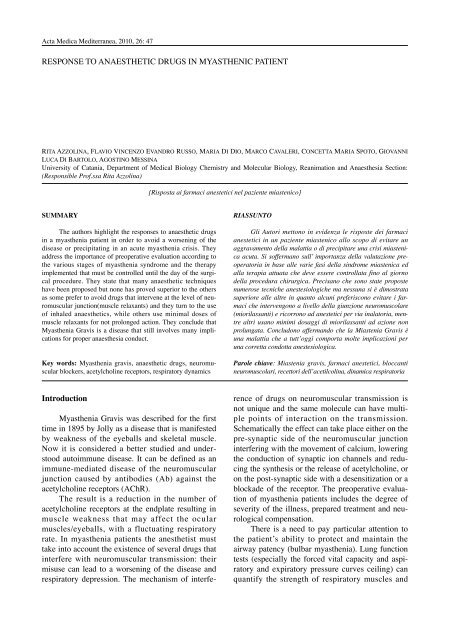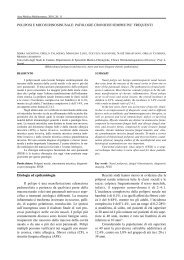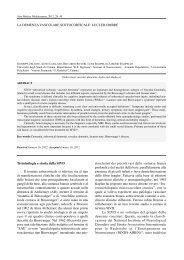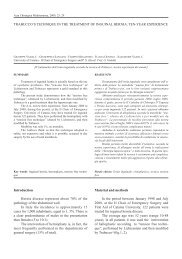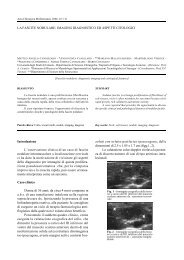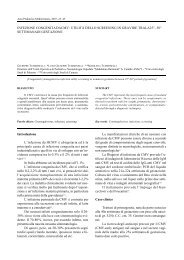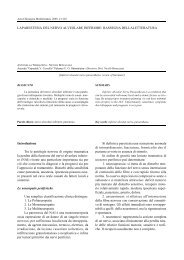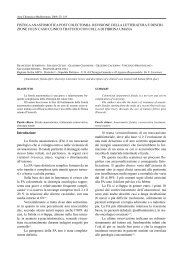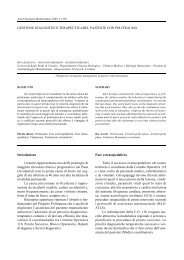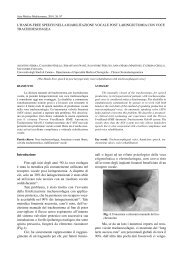RESPONSE TO ANAESTHETIC DRUGS IN ... - Carbone Editore
RESPONSE TO ANAESTHETIC DRUGS IN ... - Carbone Editore
RESPONSE TO ANAESTHETIC DRUGS IN ... - Carbone Editore
You also want an ePaper? Increase the reach of your titles
YUMPU automatically turns print PDFs into web optimized ePapers that Google loves.
Acta Medica Mediterranea, 2010, 26: 47<br />
<strong>RESPONSE</strong> <strong>TO</strong> <strong>ANAESTHETIC</strong> <strong>DRUGS</strong> <strong>IN</strong> MYASTHENIC PATIENT<br />
RITA AZZOL<strong>IN</strong>A, FLAVIO V<strong>IN</strong>CENZO EVANDRO RUSSO, MARIA DI DIO, MARCO CAVALERI, CONCETTA MARIA SPO<strong>TO</strong>, GIOVANNI<br />
LUCA DI BAR<strong>TO</strong>LO, AGOST<strong>IN</strong>O MESS<strong>IN</strong>A<br />
University of Catania, Department of Medical Biology Chemistry and Molecular Biology, Reanimation and Anaesthesia Section:<br />
(Responsible Prof.ssa Rita Azzolina)<br />
SUMMARY<br />
The authors highlight the responses to anaesthetic drugs<br />
in a myasthenia patient in order to avoid a worsening of the<br />
disease or precipitating in an acute myasthenia crisis. They<br />
address the importance of preoperative evaluation according to<br />
the various stages of myasthenia syndrome and the therapy<br />
implemented that must be controlled until the day of the surgical<br />
procedure. They state that many anaesthetic techniques<br />
have been proposed but none has proved superior to the others<br />
as some prefer to avoid drugs that intervene at the level of neuromuscular<br />
junction(muscle relaxants) and they turn to the use<br />
of inhaled anaesthetics, while others use minimal doses of<br />
muscle relaxants for not prolonged action. They conclude that<br />
Myasthenia Gravis is a disease that still involves many implications<br />
for proper anaesthesia conduct.<br />
Key words: Myasthenia gravis, anaesthetic drugs, neuromuscular<br />
blockers, acetylcholine receptors, respiratory dynamics<br />
Introduction<br />
Myasthenia Gravis was described for the first<br />
time in 1895 by Jolly as a disease that is manifested<br />
by weakness of the eyeballs and skeletal muscle.<br />
Now it is considered a better studied and understood<br />
autoimmune disease. It can be defined as an<br />
immune-mediated disease of the neuromuscular<br />
junction caused by antibodies (Ab) against the<br />
acetylcholine receptors (AChR).<br />
The result is a reduction in the number of<br />
acetylcholine receptors at the endplate resulting in<br />
muscle weakness that may affect the ocular<br />
muscles/eyeballs, with a fluctuating respiratory<br />
rate. In myasthenia patients the anesthetist must<br />
take into account the existence of several drugs that<br />
interfere with neuromuscular transmission: their<br />
misuse can lead to a worsening of the disease and<br />
respiratory depression. The mechanism of interfe-<br />
[Risposta ai farmaci anestetici nel paziente miastenico]<br />
RIASSUN<strong>TO</strong><br />
Gli Autori mettono in evidenza le risposte dei farmaci<br />
anestetici in un paziente miastenico allo scopo di evitare un<br />
aggravamento della malattia o di precipitare una crisi miastenica<br />
acuta. Si soffermano sull’ importanza della valutazione preoperatoria<br />
in base alle varie fasi della sindrome miastenica ed<br />
alla terapia attuata che deve essere controllata fino al giorno<br />
della procedura chirurgica. Precisano che sono state proposte<br />
numerose tecniche anestesiologiche ma nessuna si è dimostrata<br />
superiore alle altre in quanto alcuni preferiscono evitare i farmaci<br />
che intervengono a livello della giunzione neuromuscolare<br />
(miorilassanti) e ricorrono ad anestetici per via inalatoria, mentre<br />
altri usano minimi dosaggi di miorilassanti ad azione non<br />
prolungata. Concludono affermando che la Miastenia Gravis è<br />
una malattia che a tutt’oggi comporta molte implicazioni per<br />
una corretta condotta anestesiologica.<br />
Parole chiave: Miastenia gravis, farmaci anestetici, bloccanti<br />
neuromuscolari, recettori dell’acetilcolina, dinamica respiratoria<br />
rence of drugs on neuromuscular transmission is<br />
not unique and the same molecule can have multiple<br />
points of interaction on the transmission.<br />
Schematically the effect can take place either on the<br />
pre-synaptic side of the neuromuscular junction<br />
interfering with the movement of calcium, lowering<br />
the conduction of synaptic ion channels and reducing<br />
the synthesis or the release of acetylcholine, or<br />
on the post-synaptic side with a desensitization or a<br />
blockade of the receptor. The preoperative evaluation<br />
of myasthenia patients includes the degree of<br />
severity of the illness, prepared treatment and neurological<br />
compensation.<br />
There is a need to pay particular attention to<br />
the patient’s ability to protect and maintain the<br />
airway patency (bulbar myasthenia). Lung function<br />
tests (especially the forced vital capacity and aspiratory<br />
and expiratory pressure curves ceiling) can<br />
quantify the strength of respiratory muscles and
48 R. Azzolina, F.V.E. Russo et Al<br />
give you an idea of the need for postoperative ventilator<br />
support. The preoperative management of the<br />
patient can then be influenced by surgical technique<br />
and the choices of the anaesthesiologist. In some<br />
cases, you can stop the administration of anticholinesterases<br />
on the morning of the operation to reduce<br />
the need for the use of curare. Plasmapheresis or<br />
steroids can improve the preoperative condition of a<br />
patient with limited respiratory reserve. For myasthenia<br />
patients already receiving immunosuppressive<br />
treatment (corticosteroids, azathioprine,<br />
cyclophosphamide), the doses of drugs should not<br />
be changed due to the risk of triggering a poussèe<br />
of the disease.<br />
Use of anaesthetic drugs in myasthenia patients<br />
Curare drugs are potentially the most dangerous<br />
among those used for myasthenia. Curare<br />
relaxants are theoretically used in untreated myasthenia,<br />
although in some cases you may experience<br />
a relative resistance. During a patient’s recent<br />
treatment with anticholinesterases or plasmapheresis<br />
their use becomes random and their effects<br />
unpredictable with a high risk of establishing a<br />
curarizing prolonged block type II. Indeed electromyography<br />
studies have shown that the response<br />
to succinylcholine is difficult to predict in the case<br />
of myasthenia, whether treated or not. For these<br />
reasons it is appropriate to refrain from using them<br />
in the presence of myasthenia.<br />
The myasthenia patient is sensitive to no depolarizing<br />
curare, in fact the use of small doses as a<br />
priming or prior use of curare relaxants should be<br />
avoided because it may lead to a loss of airway protection<br />
and respiratory distress equivalent to that<br />
induced by normal doses in healthy individuals.<br />
Recommended doses are 4-8 times smaller, yet very<br />
different due to the evolution of the disease from<br />
person to person, the disparity in the muscle groups<br />
involved and the possibility of potentiating associated<br />
with drugs. No rule can be stated precisely.<br />
The use of curare in the course of no depolarizing<br />
myasthenia requires close monitoring.<br />
Sensitivity to no depolarizing curare has been<br />
described in patients with minimal impairment<br />
(ocular symptoms), those with apparent remission<br />
or in those with undiagnosed myasthenia. Longacting<br />
curare such as d-tubocurarine, pancuronium,<br />
pipercuronium and doxacurium should be avoided.<br />
Medium and short half-life curare can be used with<br />
extreme caution and with monitoring of neuromu-<br />
scular transmission, preferably with a<br />
Electromyography (EMG) or meccanomiografia<br />
(MMG), which measures the electrical response or<br />
mechanical change to the stimulation of peripheral<br />
nerves. Although in literature individual doses are<br />
reported (e.g. vecuronium from 0.005 to 0, 03 mg /<br />
kg etc.) there is wide variability in response from<br />
patient to patient and it is difficult to predict the<br />
duration and effect even with short half-life curare<br />
such as mivacurium and pyridostigmine, which<br />
inhibits the metabolism of mivacurium. In the<br />
second case studies are reported which indicate the<br />
rapid onset of cisatracurium and a more prolonged<br />
cuarizing effect. Although the use of curare is possible<br />
through adequate monitoring, their use is seldom<br />
necessary.<br />
Barbiturates in experiments on animals have<br />
shown to moderately increase neuromuscular<br />
blockade induced by no depolarizing curare,<br />
without lengthening the duration. In humans few<br />
changes have been observed. In fact, it was demonstrated<br />
that these drugs increase the amount of<br />
acetylcholine released at the pre-synaptic, but<br />
decrease the sensitivity of the postsynaptic membrane.<br />
Balancing these two effects leads to no change<br />
of neuromuscular blockade. Ketamine leads to a<br />
desensitization of the postsynaptic membrane, but<br />
does not promote the release of acetylcholine.<br />
Its effects lead to more of an aggravation of<br />
neuromuscular blockade. Propofol has the theoretical<br />
advantage of a short duration of action with no<br />
effect on neuromuscular transmission.<br />
Morphinomimetics at usual doses do not interfere<br />
with neuromuscular transmission and can be<br />
used safely as anaesthesia for myasthenia patients<br />
although the danger of respiratory depression<br />
should be considered. Remifenatnil for the short<br />
half-life (9.5 minutes) could be considered the ideal<br />
analgesic, although in literature at present there are<br />
no data on its use. The use of benzodiazepines in<br />
myasthenia is not recommended and for some<br />
authors it is formally contraindicated, however, this<br />
does seem to be excessive.<br />
Their actions at the level of neuromuscular<br />
transmission are relatively small and comparable to<br />
those of barbiturates. Harmful properties of benzodiazepines<br />
are those muscle relaxants, an effect<br />
related to increasing level of medullar inhibitory<br />
GABA on muscle tone but not on neuromuscular<br />
transmission. The use of benzodiazepines during<br />
myasthenia is therefore possible with prudence and<br />
by decreasing the dosage. Droperidol has no effect
Response to anaesthetic drugs in myasthenia patients 49<br />
on neuromuscular transmission while phenothiazines<br />
appear to interfere with neuromuscular transmission<br />
as a result of postsynaptic desensitization.<br />
All halogenated anaesthetic agents can depress the<br />
function of the tractor units muscles. This effect can<br />
be significant and occur at several levels: central<br />
depressant effects, stabilizing effect of the membrane<br />
with a decrease in membrane conductance of<br />
calcium channels and above all depressant effects<br />
on the functioning of the postsynaptic membrane.<br />
They do not seem to have a direct action on ach<br />
receptors. In practice, they determine a depolarizing<br />
block, with a more pronounced effect in the case of<br />
halothane rather than enflorano or the isofluorane.<br />
In healthy subjects they allow for a decrease<br />
of 25% to 50% in the need for curare, while in<br />
myasthenia patients they often determine an acceptable<br />
muscle relaxant for the duration of surgery. If<br />
nitrous oxide has no documented effect on neuromuscular<br />
transmission and can be used in such<br />
patients without any precaution, isofluorane reduces<br />
T1 and train of four, T1 on T4 relationship with<br />
an effect of muscle relaxant two times higher than<br />
halothane.<br />
Enflorano instead can lead to muscle relaxant<br />
with varying and heavily dependent on the severity<br />
of myasthenia. Sevofluorane 2.5% suppresses the<br />
electromyographic response to T1/Tc with 47% and<br />
T4/T1 at 57% so much so that it has been used in<br />
some cases of thymectomies by transternale both as<br />
vapour and as a muscle relaxant anaesthetic. In normal<br />
patients undergoing anaesthesia with desflorane<br />
the curare request is reduced, and this gas due to<br />
its low solubility and its subsequent rapid washout<br />
may have interesting implications in myasthenia,<br />
both for muscle relaxant properties that would<br />
allow for the surgical procedure without the addition<br />
of curare, and for the rapid elimination.<br />
Local anaesthetics act as agents for rapid ion<br />
channel blockers, suppressing the propagation of<br />
nervous transmission, the release of Ach, the sensitivity<br />
of the postsynaptic membrane and the exciting<br />
of muscle cell. Local anaesthetics also increase<br />
neuromuscular blockade of all no depolarizing<br />
curari and seem able to decrease neuromuscular<br />
transmission in myasthenia gravis. Loco-regional or<br />
local anaesthesia should be practiced using smaller<br />
doses of local “amid” anaesthetics with the<br />
“Estereo” group (procaine, tetracaine), already<br />
widely out of use, should not be used in myasthenia<br />
treated with anticholinesterases as they are metabolized<br />
by plasma cholinesterase, with an increase in<br />
the rate of serum and with it toxic effects. The<br />
blocking of the nerves of the intercostals is not<br />
advised due to deficiency of respiratory dynamics,<br />
and recently there have been reports of epidural<br />
anaesthesia in thymectomies by trasternale.<br />
Discussion<br />
The considerable progress in anaesthesia, in<br />
recent years has allowed for the use of new drugs<br />
such as propofol, mivacurium, cisatracurium, sevorane,<br />
desfluorane and remifenatanil, due to their<br />
easy handling and reduced side effects allow for the<br />
execution of a balanced anaesthesia or a TIVA<br />
without risks in myasthenia patients.<br />
Volatile anaesthetics and curare with longer<br />
half-life make the approach even more secure in<br />
myasthenia patients. Studies previously mentioned<br />
and the experience gained in the field led to the<br />
embrace of surgery such as the attitude of “Miniinvasive<br />
Anaesthesiology”or rather minimal<br />
“Pharmacological Aggression” in patients with<br />
myasthenia. Current guidance is designed to favour<br />
recently introduced drugs such as propofol and<br />
remifentanil, intravenous anaesthesia (TIVA) in<br />
accordance with the more recent method of infusion<br />
(TCI site effect or plasma concentration), the<br />
desfluorane or sevorane if the choice is to use a<br />
balanced anaesthesia.<br />
These drugs are united by the following common<br />
properties; easy handling, a rapid wash-in, low<br />
half-life, and therefore rapid wash-out with fast elimination<br />
and minimal side effects.<br />
References<br />
1) Abel M, Eisenkraft JB. Anesthetic Implication of<br />
Myasthenia Gravis. The mountsinai journal of medicine<br />
January/March 2002: 32-36.<br />
2) Jaretzki A III, Barohn R J, Ernstoff R M. Myasthenia<br />
gravis: Recommendations for clinical research standards.<br />
Neurology Vol 55 (1), 12 July 2000: 16-23.<br />
3) Kawamata M, Miyabe M, Nakae Y, et al. Contunuous<br />
thoracic epidural blockade in combination with general<br />
anaesthesia with nitrous oxide, oxygen, and<br />
sevoflurane in two patients with myasthenia gravis.<br />
Masui 1993; 42: 898-901.<br />
4) Leventhal S R, Orkin F K, Hirsh R A. Prediction of the<br />
need for post-operative mechanical ventilation in<br />
myasthenia gravis. Anestesiology, 1980, 53: 26-30.
50 R. Azzolina, F.V.E. Russo et Al<br />
5) Osserman KE. Clinical aspects. In Osserman KE, ed<br />
Myasthenia gravis. New York, NY: Grun & Stratton,<br />
1958: 79-80.<br />
6) Riacciardi R e Fontana G.P., Vivere la miastenia.<br />
Franco Angeli, 2006.<br />
7) Reider P, Louis M, Jolliet P et al. The repeated measurement<br />
of vital capacity is a poor predictor of need for<br />
mechanical ventilation in myasthenia gravis. Intensive<br />
Care Med. 1995 Aug; 21 (8): 663-8.<br />
__________<br />
Request reprints from<br />
Dott. RUSSO FLAVIO V<strong>IN</strong>CENZO<br />
Via Messina, 109<br />
97011 Acate (RG)<br />
(Italy)


